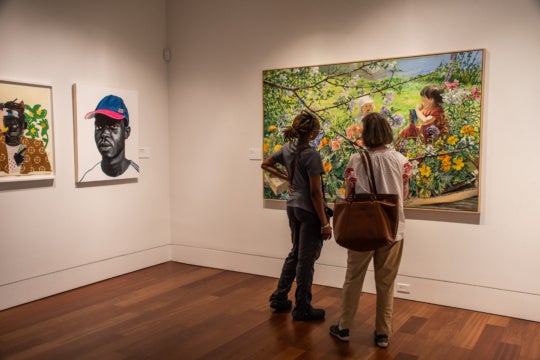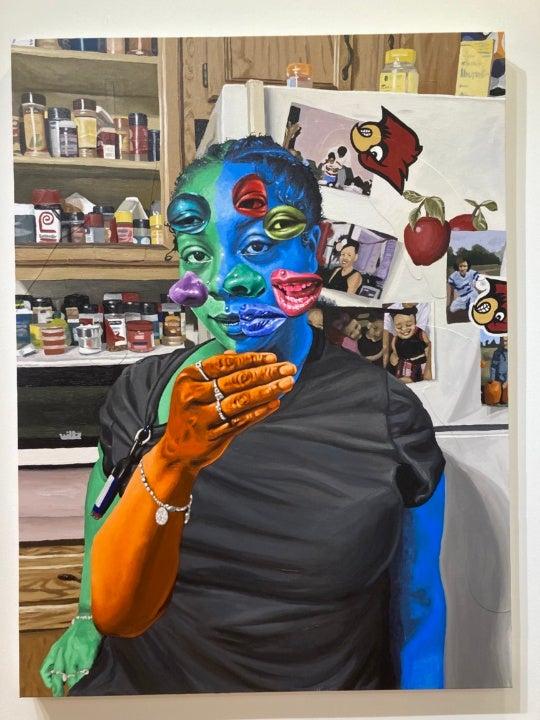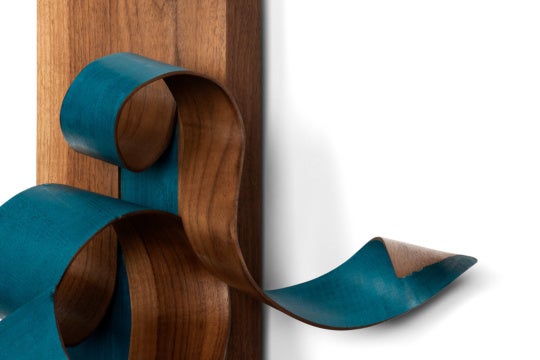
At its inception, photography’s goal was simply to capture an image. Over time, photographers and the market became obsessed not only with representation but with technical skill, including questions of the inviolability of the surface and the notion of the pristine print — perfection from emulsion to paper.
For native Atlantan Stephanie Dowda, who is now based in Richmond, that type of thinking is old-fashioned. The works in “Traces,” on view at Whitespace through February 11, are visual manifestations of physical decay. As she writes in her artist’s statement, 33 Marks—a series of distressed negatives—chronicles the illness and recent loss of her mother. At times intimate, at others expansive, these works seem to bear Dowda’s trauma and struggle on their surfaces.
The smallest works are the most engaging and effective. Surrounded by an inky, murky, blackness, the contact prints feel like they are floating in a void. The first image visitors encounter in the gallery, First Crease, is also metaphorically the first rupture; the single flaw in the negative slicing through the picture space is a flash of light on the side. When viewers encounter All the Get-Well Cards in the World, depicting what appears to be a stone wall or a berm, the surface of the work looks as if it were crushed under its own subjective weight.

As the photos grow larger, their surface interventions feel more intentional and their metaphorical connections tend toward the cinematic instead than the static. Rather than just harking back to the early history of photography, both the scale and the gothic subject of the works invite viewers to feel as if they have stepped onto the set of a low-budget horror film. Based on her artist’s statement, life may well have felt like one for Dowda. As the photographs increase in size, flaws become more evident. By the time viewers reach her 2016 image Longest Day of Light—presumably referring to the summer solstice—Dowda has folded, creased, or scratched the negatives, resulting in what look like rays of light across the work’s surface. The installation of works takes viewers on a journey from small, dark, and intimate to large, light, and expansive.

Her series Evoco combines physicality with imagery by combining an actual Claude Glass — a convex black glass that reflects and abstracts the space around it— and softly edged black-and-white images. The title, possibly drawn from the Portuguese verb evocar—to evoke—can be translated as “I evoke.” Think of these works as Dowda’s visual conjurings. At its most subtle, the Claude Glass connects viewers with the works in unexpected ways, as it does when it just peeks out from behind the lower right of Extinct Constellation After. More directly, it draws the viewer into the diptych Trails, situated right at the center of the work. When Dowda removes the Claude Glass from her constructions, as she does in the works Message and Listening, she lets the photographic image itself reinforce the idea of the spiritual, which helps her title Talking to Ghosts manifest itself. Since people of every age, in every era, have been obsessed by the spiritual and the paranormal, Dowda’s Evoco series situates itself well within those dialogues that make us both hopeful for and uneasy about the possibilities of what lies beyond.

Whether beginning with the intimate images of personal loss, as she does in 33 Marks, or exploring the subtler and seductive ideas of the supernatural, Dowda’s complex, wrought surfaces challenge our expectations of “proper photography.” This makes her exhibition Traces one that suggests that a flaw on the surface of an image can reflect the flaws that mirror what the camera captures in the instant that the shutter closes.
“Stephanie Dowda: Traces” is on view at Whitespace through February 11.
Brett Levine is an independent curator, writer, and editor based in Birmingham.




